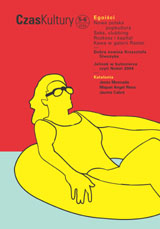Barcelona (po)olimpijska. Miasto i literatura
(Post)Olympic Barcelona. The City and Literature
Author(s): Barbara ŁuczakSubject(s): Cultural Essay, Political Essay, Societal Essay
Published by: Stowarzyszenie Czasu Kultury
Summary/Abstract: Barbara Łuczak: (Post)Olympic Barcelona. The City and Literature The high aspirations of democratic Barcelona The Olympic Games and the prestige of the Catalonian metropolis The many faces of Barcelona in literature After the death of Franco, Spain could finally give a sigh of relief and begin a new life. In this new democratic climate Barcelona strived for rapid economic and cultural growth. Hence, the great efforts made to host the Olympic Games (since this spectacular event of international significance would support the city’s far-reaching aims) which were crowned with success in 1992. The Barcelona Olympic Games were preceded with numerous expensive urban planning and architectural projects that changed the city’s image. These were guided by the slogan: Barcelona, posa’t guapa! (Barcelona, Become Beautiful). Since then the Catalonian capital has become an extremely popular destination for tourists from all over the world. But the inhabitants do not always share the enthusiasm of the city authorities for the beautiful and open image of Barcelona because their daily life does not always coexist too well with the resulting influx of tourists. The dynamic growth of Barcelona, which started in the 1980’s, has also affected the literary environments. A good example of this is L’illa de Maians (The Island of Maians), 1985, a collection of short stories written by Quim Monzó. These refer to the issue of adapting to a new reality and the relations between people in a superficially familiar life that is, nevertheless, ruled by a lack of mutual understanding, egocentrism and “a feeling of deep alienation”. Another example is The City of Marvels (La ciudad de los prodigios), 1986, written in Spanish by Eduardo Mendoza who depicts the capital city of Catalonia in the context of the 1929 and 1988 World Exhibitions. This, however, is done in a way which obviously relates to modern history and the power structures of our times. A different image is portrayed in Fragilitat de les parets (The Sensitivity of Walls), 2002, a novel by Mercé Ibarz, which shows the city from the perspective of architects and town planners contrasted with a Barcelona inhabited by the tenants of old and unique buildings. Carme Riera’s La meitat de l’ánima (Half a Soul), 2004, is also an intriguing read: “from beyond the image of Barcelona immersed in the frantic activity of a modern metropolis is revealed a Barcelona from the civil war and the Franco period”. Another attempt to reveal the truth about Barcelona obscured by its modern postcard façade is the collection of short stories by Joan Rendé, La pedra a la sabata (A Stone in the Shoe), 2004. So what is Barcelona really like? It is a city of many faces.
Journal: Czas Kultury
- Issue Year: 2004
- Issue No: 05-06
- Page Range: 168-177
- Page Count: 10
- Language: Polish
- Content File-PDF

